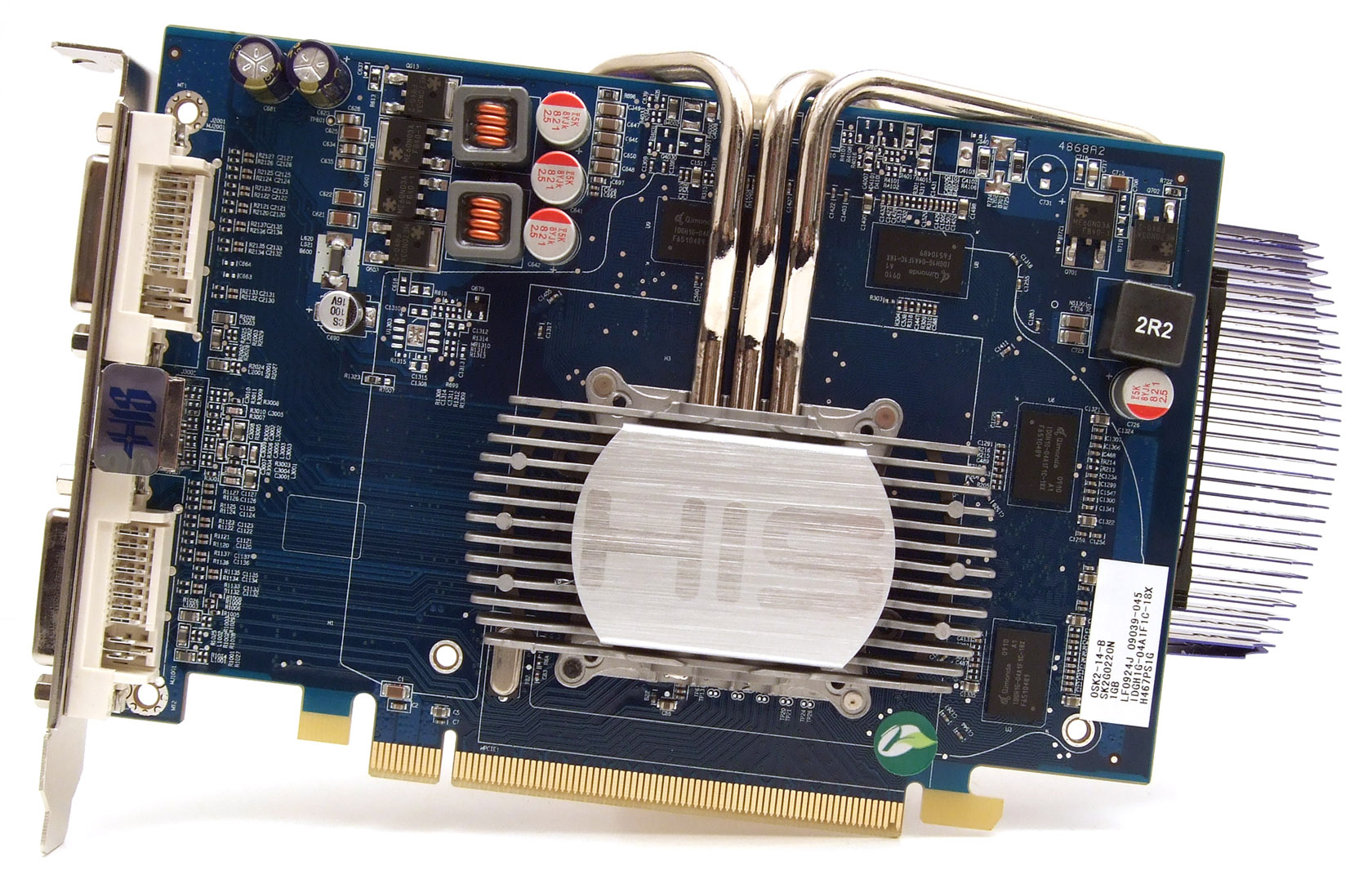Roundup: Mainstream Graphics Cards From ATI And Nvidia
HIS H467PS1GP iSilence (Passively-Cooled Radeon HD 4670, 1,024 MB)
To see all the photos in our gallery for this card, click the image below.
HIS offers a passively-cooled version of the Radeon HD 4670, which allows it to operate in complete silence. The Zalman cooler on the top side of the board is sufficiently slim to make it only a single slot wide, with additional cooling fins projecting from the rear edge. To ferry the heat to the cooling fins, the GPU cooler incorporates three large heat pipes. There’s almost one inch of space from the bottom of the card to the first cooling fin at the rear, which leaves enough room to pop this card onto an Asus P6T motherboard without impinging upon any of its onboard components.
The memory clock on this passively-cooled card is somewhat lower than the reference value, probably to help keep things cool. The reference designs run at 1,000 MHz, which HIS reduces to 850 MHz here. Nevertheless, you’ll also find 1 GB of GDDR3 RAM at your disposal. The other settings match those found on the ATI reference model design: a 750 MHz clock speed for the GPU, DirectX 10.1, and 320 stream processors.
In 2D mode, the card clocks down to 600/700 MHz (GPU/RAM) while the reference design goes quite a bit lower to 165/250 MHz. That’s why this card consumes 9 W more power than a normal Radeon HD 4670 does during desktop use, but it also consumes 2 W less during heavy 3D mode operation "thanks" to its lower memory clock under load.
The passively-cooled Zalman VNF 100 iSilence4 cooler and the Radeon HD 4670 GPU work extremely well together. In 2D mode, the card runs at 41° C, three degrees lower than the reference model. Under a heavy 3D load, temps climb to 70° C, 13 degrees cooler than the actively-cooled reference card. In both cases, the Radeon HD 4670 benefits from airflow from the CPU cooler, which is right next to the cooling fins for the Zalman cooler. Those who can use this card in a case with good air circulation should also enjoy the same low operating temperatures.
When it comes to 3D performance, the reduced memory clock rate lowers overall frame rates by about 10%, or 10.4 frames per second (FPS). Those who game with the graphics quality slider set to high, or with DirectX 10 effects turned on, should probably turn off AA at higher resolutions. Although the card's equipped with 1,024 MB of graphics RAM, this makes that memory somewhat less useful than it might be otherwise. The retail package includes no video cables, but no additional power cable is needed for this card, either. The Radeon HD 4670 gets all the power it needs from the PCI Express (PCIe) bus. A bundled DVI adapter makes HDMI connectivity available, and the card is 7.9"(20 cm) long, including its cooling fins.
Get Tom's Hardware's best news and in-depth reviews, straight to your inbox.
Current page: HIS H467PS1GP iSilence (Passively-Cooled Radeon HD 4670, 1,024 MB)
Prev Page Graphics Chips Compared And Test Configuration Next Page HIS H467QT512P (Radeon HD 4670, 512 MB)-
Bloodblender All I can say is that Tom's recent articles have been an excellent read, and this exactly the stuff I (as well as many others) require for their research purposes. Keep up the great work!Reply -
dirtmountain Nice article,very well done, but you need to show the 4670 in CF as costing $162, not $81 as shown in the final chart.Reply -
rambo117 the iceQ concept is amazing. keeps my 3870s nice and chilly (70C) while hardcore gamingReply
and not to mention they both look intimidating in my case ;) -
to me the gaming benches are most important but energy efficiency and heat dissipation run a close 2nd. thanks for providing it all!Reply
-
Julianbreaker Newegg has quite a few 4850s that retail for $100 and it appears to be getting consistently better benchmarks than the 4770. I am confused as to why you would not recommend it over the 4770. Perhaps you are confused by simple maths.Reply -
radiowars PijQuick question - 4770 in crossfire or single 4890 best bet???..They already did a whole article on that...Reply -
bucifer I don't understand why you still won't use the 1GB version of the Radeon 4870. It's clear to me that the card is limited by it's amount of video memory when using hi-res, AA and AF.Reply
Searching for prices in US and Europe it retails cheaper than the GTX260(192 or 216).
The point is: the card should be included in the test just as the GTX260-216. It's clearly a better option than the 512 mb version and it's good for comparison! -
holodust Nice article, but I don't see how testing these cards on i7 920@3.8 fits into mainstream.Reply
